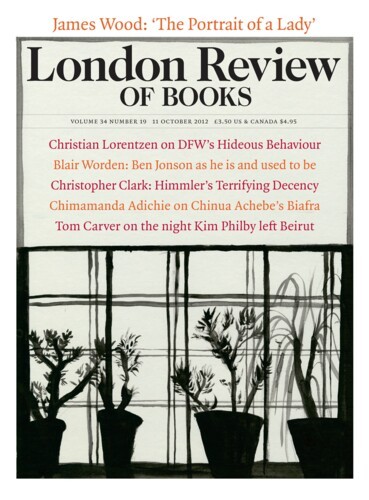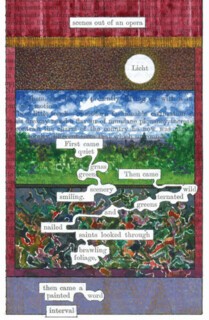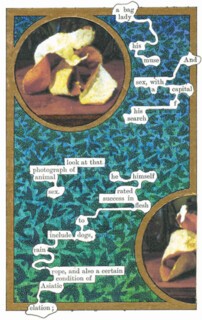On a Saturday morning in November 1966, Tom Phillips picked a book at random from a pile of novels at a house-clearance sale in Peckham Rye. Phillips had never heard of W.H. Mallock’s A Human Document (1892), but he liked the title and the yellow cover and handed over threepence. Back at his kitchen table, Phillips began a process of remaking or ‘treating’ the book: by painting over most of each page with acrylic gouache or ink, he left visible a stream of text which, in dialogue with the images he added, told a new story. By folding the title-page, Phillips contracted the words ‘a human document’ into a neologism he liked: ‘a humument’. ‘An earthy word,’ he writes in the afterword to this fifth edition, ‘I like even the effortful sound of it.’
A Humument is a strange, beguiling work, which Phillips found within Mallock’s long-forgotten novel. A Human Document opens: ‘The following work, though it has the form of a novel, yet for certain singular reasons hardly deserves the name.’ Phillips obscures most of the first page with a blue and orange arrow, leaving a few scattered words that cohere into a version of the opening of Virgil’s Aeneid (‘I sing of arms and of a man’): ‘I sing a book of the art that was/now read on/of mind art/though I have to hide to reveal.’ He treats each page of Mallock’s novel in this way, effacing most of the text, generally by painting, occasionally by cutting, slicing, or even in one instance burning the page, to leave an alternative narrative. Phillips’s revealed story was in one sense always there in Mallock, just lost amid the torrent of other text. This is authorship as pruning, a process of erasure or cutting away that finds in the buttoned-up A Human Document a teeming world of humour, sex, sadness and art that would have baffled and shocked the conservative Mallock.
There is something like a plot. Characters with Pynchonesque names (Ted Wink, Eve Sardine, Stan Gage, Alf Rosp, Al Plish, Mrs Mornspot) make brief appearances, but A Humument is centrally the bumpy love story of Irma and Toge – ‘the film of our lamp-lit history’, Toge calls it – glimpsed in elliptical, non-linear fragments: ‘more like a pack of cards’, Phillips notes, ‘than a continuous tale’. Irma featured in Mallock’s original, but Toge is the creation of one of the rules that govern much of Phillips’s creativity: every time the words ‘together’ or ‘altogether’ appear in Mallock’s text (the only words from which ‘toge’ can be extracted), Phillips conceals all the letters necessary to leave ‘toge’ standing alone. Despite Phillips’s mode of composition, something like a traditional sense of character emerges: Toge is uncertain, a worrier, fragile. We feel for him as he grasps clumsily after love and happiness: ‘sad toge watching the waves fall repeating Certain sorts of verse.’
Spliced together with the love story are satirical vignettes of a jostling world of gallery openings ‘full of arty London gossip’: ‘The critics make me ill, ducky’; ‘kiss kiss English art’; ‘Just look at Julian.’ Phillips discovers in Mallock’s novel a version of his own life: A Humument is, in part, a kind of autobiography, and a reflection on growing old (‘memory, turning seventy, renewed, with a muse of quaint treated news’). ‘At last,’ the text exclaims over a portrait of Phillips in cricket whites painted over page 50, ‘welcome! my own myself.’ (For his 50th birthday in 1987, Phillips hired the Oval for ‘TP XI vs. The Rest Of The Artworld’.) A Humument nods quietly at Phillips’s other projects: ghostly, Francis Bacon-like images recall his career as a portrait painter and Royal Academician; sliced photographs invoke his Postcard Century, which portrays each year of the 20th century through hundreds of annotated postcards; and a pasted-in A-Z excerpt features the twenty South London locations where, since 1973, Phillips has taken a photograph on the same day each year. ‘The gallery of a hundred years,’ Mallock’s doctored text reveals, ‘of a thousand is in every street.’
Phillips is a lover of games and chance and rules. With Brian Eno – his pupil at Ipswich Art School in the early 1960s – he invented ‘sound tennis’, striking a ball against five pianos with their workings exposed, and scoring according to the sounds produced. In A Humument, Phillips deploys what he calls ‘invited accident’: in the 1987 edition, coin tosses dictated which words should be struck out on page 99 of Mallock, until there were only two left standing: ‘something already’. (This page, along with many others, has been remade in the newest edition: there’s a particular pleasure in seeing the same pages reinvented across A Humument’s five incarnations, spanning forty years.*)
A Humument is extremely funny, and the comedy depends on what Phillips calls Mallock’s ‘complete lack of humour’. Mallock’s story of the affair between Irma and Grenville is shot through with anti-semitism and a reverence for the aristocracy that makes for difficult reading today. Phillips works Mallock’s stiff prose into a jaunty, surreal bawdiness (‘fancy him, darling?’): the effect is rather like Arthur Balfour voicing Sid James. ‘Enter toge,’ Chapter 1 begins, ‘wheeled slowly in by French and German ladies of vague conditions in life.’ Or: ‘he himself rated success in flesh to include dogs, rain rope, and also a certain condition of Asiatic elation.’ Or: ‘art officers in uniform, the prettiest officer making the most of his cheeks’. Or: ‘on a sofa the porter found himself damp and it was not last night’s smell.’ Or: ‘a fart for moralists’. Or: ‘Paul Veronese. he suddenly ejaculated, You know Veronese – above the sideboard. up in the cupboard on the wall; On the contrary.’ Or, more simply: ‘up yours’. Phillips uses mise-en-page, spreading sparse text over the space of the page, to control our reading speed. The spatialised text makes for perfect comic timing. When we read ‘he showed me a certain photograph./posed/ I dare say,/of/the/waterworks at Bucharest,’ the text trickles vertically down the page with the effect of a slurred anecdote – most of Mallock’s original recedes behind red cross-hatching – and the gaps between the words create a delay that brings to life the final, unpredicted ‘waterworks at Bucharest’. Elsewhere, an entire page of Mallock’s prose is crossed out to leave only five words: ‘evening Arthur calm your member.’
The reeling comic voice that Phillips finds buried inside Mallock – ‘on the philosophy mattress to-night My sister is going to attempt to join the morning after and Aristotle’s Ethics’ – frequently recalls other masters of strange, urgent sentences: Monty Python; Samuel Beckett; Chris Morris in Blue Jam; and perhaps most vividly of all, Vivian Stanshall in Sir Henry at Rawlinson End. In fact, A Humument is a novel of quotation: not only in the sense that all of its words were written first by Mallock (although not, as Eric Morecambe said of the notes in his piano playing, necessarily in the right order); but also because Phillips pieces together Mallock’s words to produce other writers’ lines. So there is Donne and Shakespeare, but also lines from books that in 1892 had not yet been written. Versions of E.M. Forster’s ‘only connect’ (Howards End, 1910) pop up throughout: ‘merely connect’; ‘closely connect’; ‘oddly connect’; ‘My little muse was connect connect.’ Molly Bloom’s closing words in Ulysses (1922) fill A Humument’s penultimate page (‘And I said yes – yes, I will yes’); and Ezra Pound’s Make It New (1935) is in there too. Beckett is a constant near presence, including a version of the most famous lines from Worstward Ho (1983): ‘as years went on, you began to fail better.’ The temporality of the quotation is complex: Mallock (1892) is being made to quote Beckett (1983) by Phillips (in a 2012 edition of a book he began in 1966).
Mallock’s words are made to speak prophetically in other ways, too. A Humument invokes recent technologies, including Facebook and the iPhone (‘her book now in the app of this volume’), and a particularly viscous paragraph from 1892 is cut back to the contemporary three-word injunction: ‘text him now.’ But the most striking of these temporal leaps comes when Phillips converts page 4 of A Human Document into a visual and verbal meditation on 9/11. Phillips glues in a postcard of King Kong clutching the World Trade Center, and a version of Goya’s Saturn Devouring His Children, and obscures all but 17 words from Mallock’s prose: ‘pasted on to the present/see, it is nine/eleven/the time singular/which broke down illusion.’ This treated page generates a dynamic, synaesthetic reading experience: we are offered a series of relationships between text and image; between Phillips and Mallock (parts of Mallock’s painted-over original are still just readable); between the legible and the obscured; between 1892, 2001 and 2012. To call it non-linear is to underestimate the hermeneutical possibilities: the reading eye ricochets between text and image like a pinball.
What kind of a book is this? A Humument is preoccupied by its own strange genre: the text shuffles through an array of terms that could be descriptions of the repurposed, treated curiosity in our hands (or, in the case of the Humument app, on our screens). This is ‘a museum hidden in the story of M’; ‘thinking painted on a background of painting’; ‘repeated music of your mistake’; ‘a veil thrown over a veil, as changes made the book continue’; ‘a ballet for changed characters from some inaccessible yesterday’; ‘the book of stars vibrating’; ‘pencil murmuring’; ‘plied words’; ‘the found friend a book to be recast’. A Humument is ‘that odd broken novel’, and ‘rich crude vulgar florid suggestive art’.
Yet, unique as A Humument may appear to be, it belongs to a lengthy literary-artistic tradition. The 18th-century culture of extra-illustration, or ‘grangerising’, was sparked by James Granger’s Biographical History of England (1769): readers remade books by pasting in prints of eminent figures. Four years before Phillips bought A Human Document in 1966, Joe Orton and Kenneth Halliwell anticipated Phillips’s bawdy relationship with literary inheritance by stealing books from Islington libraries and remaking them by creating new collage covers, subtitles and dustjacket blurbs. They were sentenced to six months in prison. Among other improvisations, Orton and Halliwell pasted a monkey’s head onto Collins Guide to Roses; adorned a volume of John Betjeman’s poems with a photograph of a heavily tattooed, elderly man in swimming trunks; and glued pictures of giant cats onto the cover of Agatha Christie’s The Secret of Chimneys. At about the same time, a related tradition of artists’ books reached some kind of a peak with Dieter Roth, who not only reworked found comics and newspapers, but also mixed pulped books with onions and spices to create Literature Sausage.
When Phillips stumbled across Mallock’s novel, he had just read an interview William Burroughs gave to the Paris Review in 1965, and had been experimenting with cutting up copies of the Spectator. Phillips later visited Burroughs: ‘I had a very tough day with him,’ he recalled in 2011. ‘Very fierce. Incredible. Fearsome … Generous. He took a day out of his life to spend with me. Not that we had lunch or things like that. An entirely bare room with nothing to sit on. Agony, the whole thing.’
Recent experiments with the novel’s material form are indebted to Phillips. Jonathan Safran Foer produced Tree of Codes (2010) by cutting away most of the text of his favourite book, Bruno Schulz’s short story collection The Street of Crocodiles (1934; translated into English in 1963), to leave behind a new story (slicing seven letters from ‘Street of Crocodiles’ leaves ‘Tree of Codes’); its fragile pages are largely composed of gaps. The volume is, among other things, a homage to Schulz, a Jewish writer murdered by the Nazis in 1942. Adam Thirlwell’s Kapow! features an array of typographical tricks – blank space, folded pages, blocks of text set at right angles – in an attempt to track the non-linear thinking of a narrator during the Arab Spring.
What relationship exists between Mallock and Phillips? Who is the author? The genealogical metaphors favoured by literary historians – descent, inheritance, succession – won’t quite do for A Humument. It is a double-act, across the ages, between two wildly different temperaments drawn to the same pool of words: an earlier edition records Phillips’s ‘incalculable debt to William Hurrell Mallock’, his ‘unwitting collaborator’. (Although Phillips knows much of Mallock’s novel by heart, and has accumulated an almost complete collection of his work, he has never read A Human Document from start to finish.) While Phillips’s authorship may look like a kind of destruction – A Humument refers to ‘the Unauthor’ – Mallock has done well out of the bargain. A Human Document has become a collector’s item: AbeBooks currently quotes £230. (To read Mallock’s original, now, is to read in the shadow of Phillips’s later reworking: Mallock’s finished novel appears continually not to be what it would later become.)
Phillips has spoken of A Humument as having been exhumed from, rather than born out of, Mallock’s novel; he uses metaphors of excavation and depth to describe his interaction with it: ‘The first version could be regarded as preliminary opencast mining leaving more hidden seams to be investigated.’ Thus Phillips has used A Human Document in numerous projects, including a commentary on Dante’s Inferno; an illustrated edition of Cicero’s Orations; the libretto, music, staging and costume designs for his opera Irma; and to decorate a pair of globes of imaginary worlds in the V&A. Phillips has ‘yet to find a situation, sentiment or thought’ that Mallock’s words ‘cannot be adapted to cover’.
Can we call what Phillips is doing ‘writing’, or would some other term be better? What version of authorship or creativity is at work here? A Humument is a reminder that books are inevitably intertextual – they grow out of older texts – and that all writing involves selecting words from a finite pool: what appears to be a constraint, having to work within the walls of an existing novel, in fact dramatises a condition of literature. Some technologies, the typewriter for instance, make this sense of writing qua selection vividly apparent: writers may create an infinite number of worlds, but the next action can never be more than choosing one from a small number of keys. The pen and the blank page create the illusion of creativity ex nihilo: but it is an illusion. ‘Disturb a book,’ A Humument intones: ‘doctor books … do art … modernise England.’ In fact Phillips wasn’t the first author to treat a Mallock text. Among Oscar Wilde’s books in the Old Library of Magdalen College, Oxford is a copy of Mallock’s The New Republic, or Culture, Faith and Philosophy in an English Country House (1877). One of the pages appears to be stained with jam.
Send Letters To:
The Editor
London Review of Books,
28 Little Russell Street
London, WC1A 2HN
letters@lrb.co.uk
Please include name, address, and a telephone number.



